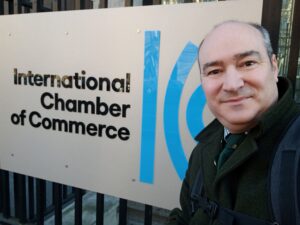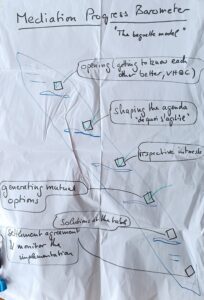
Every year since 2004, this competition has brought together law students, coaches and mediation professionals from around the world.
The competition provides the opportunity for the students to demonstrate and improve their negotiation skills, a subject not taught to undergraduates of my generation. It also brings together numerous mediation professionals in a collegiate environment. In addition to mediating and judging the competitors, the professionals can share their (de-identified) real life experiences and address topical issues together.
After two years in which the Covid-19 pandemic prevented international travel, this year’s competition took place face-to-face again in Paris from 6th to 11th February, albeit with fewer teams, fewer rounds and fewer social events than in previous years. Nevertheless, thanks to the ICC team and numerous volunteers, in addition to the student competitors and professionals, it was a great success and, with the possibility of increased sponsorship from mediation organizations and others, there is a prospect of resuming the full-blown program of the pre-Covid years.
Three reflections on the competition
Each time I come to the competition I experience learning and reflection. Meeting in person this year was a wonderful opportunity to re-engage with everything that makes this competition so special. For me there are three experiences that are worth special reflection, and I am delighted to share these with you.
My first reflection
The skills and talents of the students competing in the competition continue to grow by leaps and bounds. When I look back at the first year in 2004, which I was fortunate enough to attend, the astounding progress in skills-building that we now observe was just a faint hope. I am full of admiration and inspired to continue my own lifelong learning.
My second reflection
This concerns those who are lost to us. Over the years we have been saddened to lose giants of the competition who contributed selflessly to the establishment and continuing success of this important and enjoyable event – David Plant, Colin Wall, Thierry Garby and this year Christopher Miers, with whom I had the privilege of co-chairing the Problem Drafting Working Group, as I had with Colin. Chris’s loss hung over us as we remembered all he contributed. He would have been thrilled to see all these bright young students making such good use of materials he helped to create.
Chris would have been particularly pleased that, within the mere 85 minutes of the mediation session, the problem he drafted for this year’s Final led to agreement being reached between the winner, NALSAR University of Law (India), and the runner-up, New York Law School (USA). The University of Auckland (New Zealand) and Universita degli Studi di Trento (Italy) came third and fourth.
My third reflection
This concerns my professional colleagues whom I am given the opportunity to know a little better each year – to learn from them and to share my experiences with them. This year I am particularly grateful to the irrepressible Jean-Christophe Barth-Coullaré, who shared with me the amazing device he has created for tracking a mediation’s progress. He has given me his permission to report the tool, along with the photo that accompanies this blog post.
The amazing baguette mediation tracking device

The photo depicts what looks like a submarine but is intended to represent a French baguette, of which it appears there are at least eleven types . Jean-Christophe encouraged the mediation parties to focus on the “croûton” in his model baguette as a “Mediation Progress Barometer”, showing the baguette divided into slices. It starts at the top, which Jean-Christophe names “Opening – getting to know each other better, VHQC (Very High Quality Communication)”.
The next slice is “Shaping the Agenda – de quoi s’agit-il?”. Then “respective interests”, “generating mutual options”, “solutions at the table”, finishing at the other end with “Settlement agreement & monitor the implementation”. A box is ticked as the negotiation moves from one slice to the next. Like a real baguette (in my opinion) the two crusty “croûtons” ends are the best parts.
Could the baguette end up in court?
It is not entirely clear whether the model is admissible in court should a dispute arise over whether the parties reached agreement. The answer may depend on the jurisdiction in which the proceedings take place. Nevertheless, the model is an excellent way of explaining the process which the mediator would like the parties to follow.
Adding this tool to our repertoire
Jean-Christophe’s baguette Mediation Progress Barometer is particularly attractive to me because it does not contemplate spending unnecessary time formulating an agenda, debating the order in which topics are to be addressed and arguing over them, when simply clarifying the interests of the parties and brainstorming options for agreement is a much more productive approach. See “Getting to Yes” .
I am looking forward to whatever new piece of wizardry 2024 may bring!
________________________
To make sure you do not miss out on regular updates from the Kluwer Mediation Blog, please subscribe here.



Is this a case of no pain, no gain? Sorry!
He he!!!
The baguette model is, like all great ideas, elegantly simple in concept and execution. Probably best introduced by a crusty old mediator.!
Be my guest!!!!